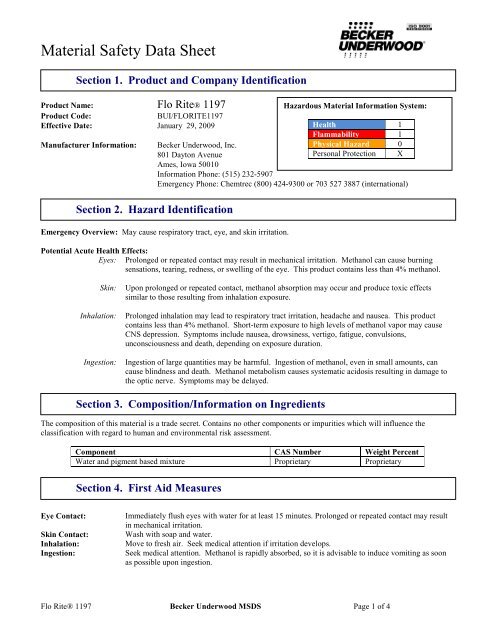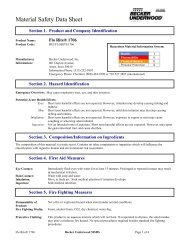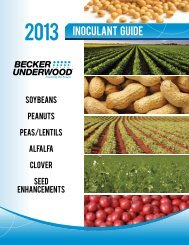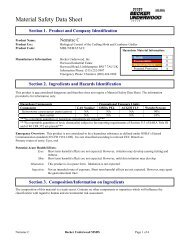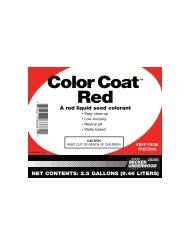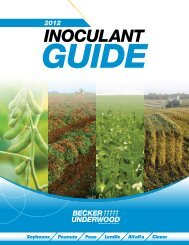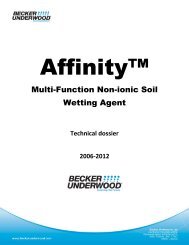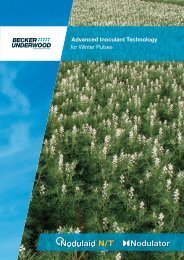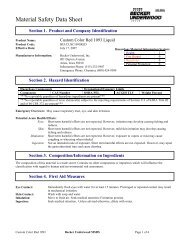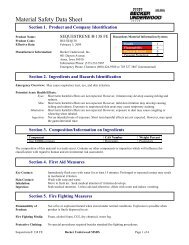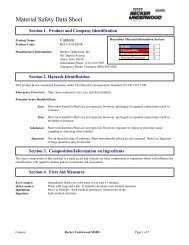Flo Rite 1197 MSDS - Becker Underwood
Flo Rite 1197 MSDS - Becker Underwood
Flo Rite 1197 MSDS - Becker Underwood
- No tags were found...
You also want an ePaper? Increase the reach of your titles
YUMPU automatically turns print PDFs into web optimized ePapers that Google loves.
Material Safety Data SheetSection 1. Product and Company IdentificationProduct Name: <strong>Flo</strong> <strong>Rite</strong>® <strong>1197</strong>Product Code:BUI/FLORITE<strong>1197</strong>Effective Date: January 29, 2009Manufacturer Information:<strong>Becker</strong> <strong>Underwood</strong>, Inc.801 Dayton AvenueAmes, Iowa 50010Information Phone: (515) 232-5907Physical HazardPersonal Protection0XEmergency Phone: Chemtrec (800) 424-9300 or 703 527 3887 (international)Section 2. Hazard IdentificationEmergency Overview: May cause respiratory tract, eye, and skin irritation.Hazardous Material Information System:Health 1Flammability 1Potential Acute Health Effects:Eyes: Prolonged or repeated contact may result in mechanical irritation. Methanol can cause burningsensations, tearing, redness, or swelling of the eye. This product contains less than 4% methanol.Skin:Inhalation:Ingestion:Upon prolonged or repeated contact, methanol absorption may occur and produce toxic effectssimilar to those resulting from inhalation exposure.Prolonged inhalation may lead to respiratory tract irritation, headache and nausea. This productcontains less than 4% methanol. Short-term exposure to high levels of methanol vapor may causeCNS depression. Symptoms include nausea, drowsiness, vertigo, fatigue, convulsions,unconsciousness and death, depending on exposure duration.Ingestion of large quantities may be harmful. Ingestion of methanol, even in small amounts, cancause blindness and death. Methanol metabolism causes systematic acidosis resulting in damage tothe optic nerve. Symptoms may be delayed.Section 3. Composition/Information on IngredientsThe composition of this material is a trade secret. Contains no other components or impurities which will influence theclassification with regard to human and environmental risk assessment.Component CAS Number Weight PercentWater and pigment based mixture Proprietary ProprietarySection 4. First Aid MeasuresEye Contact:Skin Contact:Inhalation:Ingestion:Immediately flush eyes with water for at least 15 minutes. Prolonged or repeated contact may resultin mechanical irritation.Wash with soap and water.Move to fresh air. Seek medical attention if irritation develops.Seek medical attention. Methanol is rapidly absorbed, so it is advisable to induce vomiting as soonas possible upon ingestion.<strong>Flo</strong> <strong>Rite</strong>® <strong>1197</strong> <strong>Becker</strong> <strong>Underwood</strong> <strong>MSDS</strong> Page 1 of 4
Section 5. Fire Fighting MeasuresFlammability ofProduct:Fire Fighting Media:Protective Clothing:Not a fire or explosion hazard when stored under normal conditions.Foam, alcohol foam, CO2, dry chemical, water fog.This product is an aqueous mixture which will not burn. If evaporated to dryness, the solid residuemay pose a moderate fire hazard. No special procedures required besides standard fire fightingprocedures.Section 6. Accidental Release MeasuresClean-UpProcedures:Spills and Leaks:Collect spilled material with an inert absorbent such as sand or vermiculite. Place in properly labeledand closed container. Dispose of collected material according to federal, state/provincial and localenvironmental regulations.Contain the spill or leak to prevent discharges to surface streams or storm sewers. This material is aconcentrated dye/pigment. Small quantities in contaminated water solutions will color large volumes.Section 7. Handling and StorageHandling:Storage:Avoid breathing fumes. General mechanical ventilation can be expected to effectively remove andprevent build up of any vapor or mist generated from handling this product in a closed environment.Protect eyes to prevent contact. Avoid prolonged or repeated exposure to skin.Keep container in a dry place inaccessible to children and pets at temperatures above freezing.Keep containers sealed until ready for use.Section 8. Exposure Control/Personal ProtectionHazardous ComponentsOccupational Exposure LimitsComponent CAS Number OSHA PEL ACGIH TLV Weight PercentFiller pigments* Prop. 20mppcf 3 mg/m 3 5-15%Filler pigments* Prop. 15 mg/m 3 10 mg/m 3 0-10%Methanol(Methyl67-56-1 200 ppm 200 ppm TWA~4%Alcohol)*260 mg/m 3 250 ppm STEL*Dust limits for filler pigments are applicable for dried product only.*Methanol (methyl alcohol) is subject to the reporting requirements of SARA Title III Section 313 and 40 CFR 372with a de minimis concentration of 1.0%. Methanol is also subject to the reporting requirements of the ComprehensiveEnvironmental Response, Compensation, and Liability Act (CERCLA) at a reportable quantity of 5000 lbs.Engineering controls:Personal Protection:Eyes:Other:Body:Hands:Respiratory:General mechanical ventilation can be expected to effectively remove and prevent build up of anyvapor or mist generated from handling this product in a closed environment.Wear safety glasses with side shields. Wear additional eye protection such as chemical goggles orface shield if splashing or spraying hazard exists. Have an eye wash station available.To prevent skin contact wear coveralls, apron, boots, or lab coat.Avoid skin contact by using chemically resistant gloves.No respiratory protection required under normal conditions of use. Use local exhaust to controlexcessive vapors/mists. If excessive vapors or mists are persist use appropriate NIOSH/MSHAapproved organic vapor/mist respirator.Open wounds or skin surface disruptions should be covered with a chemical resistant patch tominimize absorption risks. Clean clothing should be worn daily to avoid possible long-term build upof the product leading to chronic overexposure.<strong>Flo</strong> <strong>Rite</strong>® <strong>1197</strong> <strong>Becker</strong> <strong>Underwood</strong> <strong>MSDS</strong> Page 2 of 4
Section 9. Physical and Chemical PropertiesOdor Slight odor Vapor Density Heavier than airColor Pearlescent Evaporation Rate Slower than etherPhysical state Liquid Specific Gravity 1.0-1.1 g/mL(H 2 0 = 1)pH 7-8 Solubility DispersibleMelting/Freezing Point NASection 10. Stability and ReactivityChemical Stability:HazardousDecomposition:HazardousPolymerization:Incompatibility(Materials to Avoid):This material is chemically stable under normal storage and handling conditions.When involved in a fire, burning may evolve noxious fumes which may include carbon monoxide,carbon dioxide, nitrous oxides, acetic acid, or other toxic compounds depending on the chemicalcomposition and combustion conditions. However, all of the water must be driven off first for this tooccur.Is not known to occur.Avoid extremes in temperature, high heat sources, sparks, open flames. Long term storage in directcontact with reactive metals such as aluminum, zinc, copper, nickel, magnesium, etc. Other materialsto avoid include strong oxidizing agents.Section 11. Toxicological InformationChronic Toxicity:Mutagenic Effects:Teratogenic Effects:DevelopmentalToxicity:Acute Effects onHumans:Sensitization:Carcinogenic Effects:Existing MedicalConditions AggravatedBy Exposure:None knownNone knownNone knownRodent studies have shown that high-level exposure to methanol impairs neural tube closure andinduces other birth defectsMay cause skin, eye, and respiratory irritation.Repeated or prolonged exposure to the substance at concentration above the exposure limits maycause respiratory tract and lung sensitization.This material is not known to cause cancer in animals or humans.May provoke asthmatic response in persons with asthma who are sensitive to airway irritants.Personnel with pre-existing CNS disease, skin disorders, impaired liver or kidney function, orchronic respiratory diseases should avoid exposure to methanol.Section 12. Ecological InformationEcotoxicity:Environmental Fate:No data available, however the material is not expected to have any deleterious toxic effect.No data available regarding the environmental fate or biodegradation.<strong>Flo</strong> <strong>Rite</strong>® <strong>1197</strong> <strong>Becker</strong> <strong>Underwood</strong> <strong>MSDS</strong> Page 3 of 4
Section 13. Disposal ConsiderationsEPA Waste Number:Treatment:Non-hazardous wasteDispose of according to all federal, state/provincial and local environmental regulations.Section 14. Transport InformationD.O.T. Classification: Not regulatedIMO/IMDGNot regulatedClassification:IATA Classification: Not regulatedSection 15. Regulatory InformationUS Federal Regulations:SARA 302/304/311/312 extremely hazardous substances:SARA 302/304 emergency planning and notification:SARA 302/304/311/312 hazardous chemicals:SARA 311/312 <strong>MSDS</strong> distribution – chemical inventory –hazard identification:No products were found.No products were found.No products were found.No products were found.SARA 313: Methanol (methyl alcohol) is subject to the reporting requirements of SARA Title III Section 313and 40 CFR 372 with a de minimis concentration of 1.0%. Methanol is also subject to the reportingrequirements of the Comprehensive Environmental Response, Compensation, and Liability Act(CERCLA) at a reportable quantity of 5000 lbs.Regulatory ListingsUnited States (TSCA): ListedSection 16. Other InformationThe information is furnished without warranty, representation, inducement or license of any kind, except that it is accurate tothe best of <strong>Becker</strong> <strong>Underwood</strong>’s knowledge. Because use conditions and applicable laws may differ from one location toanother and may change with time, recipient is responsible for determining whether the information is appropriate forrecipient’s use. Since <strong>Becker</strong> <strong>Underwood</strong> has no control over how this information may be ultimately used, all liability isexpressly disclaimed and <strong>Becker</strong> <strong>Underwood</strong> assumes no liability.<strong>Flo</strong> <strong>Rite</strong>® is a trademark of <strong>Becker</strong> <strong>Underwood</strong><strong>Flo</strong> <strong>Rite</strong>® <strong>1197</strong> <strong>Becker</strong> <strong>Underwood</strong> <strong>MSDS</strong> Page 4 of 4


